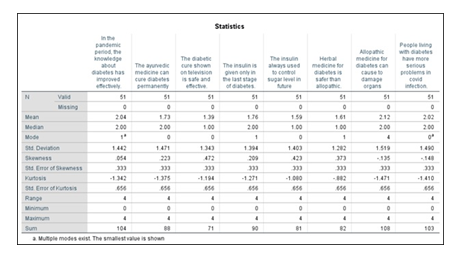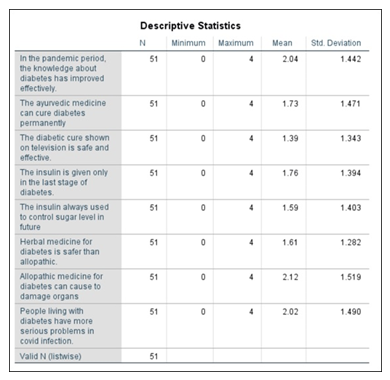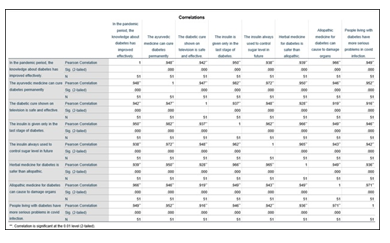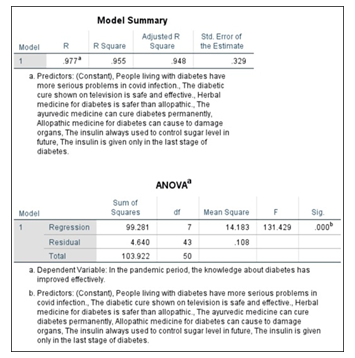Myths about Treatment of Diabetes in Common Public
Anjali Vijaya1*, Dr. Harshali Bharat Rankhambe2, Subhash Kumar1
1Anjali Vijaya, 2nd-year MBBS, Jaipur National University Medical College, Jaipur, Rajasthan, India
2Harshali Bharat Rankhambe, Associate Professor, Department of Physiology, Jaipur National
University Medical College, Jaipur, Rajasthan, India
3Subhash Kumar, Department of Medicine (MD), Diabetologist, Diabetes and Obesity Care Center, Patna, Bihar, India
*Corresponding Author: Anjali Vijaya, 2nd-year MBBS, Jaipur National University Medical College,
Jaipur, Rajasthan, India
Received: 15 July 2022; Accepted: 29 July 2022; Published: 01 October 2022
Article Information
Citation:
Anjali Vijaya. Myths about Treatment of Diabetes in Common Public. Archives of Internal Medicine Research 5 (2022): 458-463
View / Download Pdf Share at FacebookAbstract
During the pandemic situation, most of the diabetic patients are found across the state of India due to the vaccination as well as the awareness procedure held through the health organization of the state. Low availability of private organisations created a major problem during the pandemic for the diabetic patients and many patients fully dependent on the government's awareness program. This paper provides the information related to the cross-sectional research that is developed in the teaching hospitals. This research has selected 230 diabetic patients who are visiting the clinics regularly and 212 non-diabetic patients who have been participating in this interview. This data has been analysed through the SPSS software so that it can gather information related to correlation among different variables and statistical analysis of regression which is performed through model summary. Therefore, the study provides the detail information about the myths regarding the treatment of diabetes in common public through statistical analysis.
Article Details
Introduction
Diabetes can be associated with major health hazards and long term complications. The problem of diabetics has reached a pandemic. The society of India has a long record of the stage of the diabetes epidemic. The large public health problem of diabetics is growing quickly every year. Treatment of diabetes and awareness can be generated through a health education process. Myths of diabetics is shared by a large group of people to be part of cultural identity. Strong influence can effected during the treatment by the individuals in real life. The correct understanding of misconceptions and myths about the diabetic disease is important in providing health education for healthy individuals.
Indian society includes various cultural backgrounds which have a very strong influence on health seeking behaviour. Indian people believe that spirituality can be a better treatment process and alternative forms of medicine. There has included effective research to understand and generate awareness about those myths. A few studies have been done related to this subject. The research process tried to identify common myths regarding diabetes and treatment to understand the characteristics.
Objective
There little study performed to examine the myths associated with diabetes. The past research has associated to discover the treatment process [1].
- To identify the different myths regarding diabetes and its treatment in India.
- To change the mindset about the myths and misconceptions.
Methods
Design of the study:
Cross-sectional
The cross-sectional research developed in teaching hospitals in India. In the research process, 230 diabetic patients attended regular diabetic clinics and 212 non-diabetic people participated in the research. In the pre-tested interview, 10 questions were used to identify myths about diabetes [2].
Sample size: 442 participants
The Data of patients was analyzed by SPSS software. In the hospital, 122 diabetic patients attend the clinic weekly. The non-diabetic population is also included in the diabetic clinic. The interview process was prepared in the local language with the help of medical experts. The scheduled interview was administered in a normal outpatient clinic. The interview of diabetic took 10 minutes for every participant. The data collection method enrolled to avoid repetition. Every interview was rechecked to identify any missing information. The information of diabetics was collected within a period of 1 month and analyzed in SPSS software. The general myth in the society of India is that eating more sugar and sweets can causes diabetes [3]. In the other process, diabetes could only happen in old age. The feet soaking process in water could help control diabetes, blood sugar and can be cured by trusted spiritual treatment. Myths of diabetes are effectively more general in non-diabetics, females and less educated groups.
Implications
The spread of myths about diabetes is widespread in the North Indian population. poor compliance and poor health seeking behaviour with treatment can be associated in the process. The study research explains the protocol and aims of the study. Total of 470 persons approached for the study, 442 persons agreed to participate in the process. The structured interview questions contain knowledge, gender and myths regarding diabetes from the study group. Herbal medicines are taken by 13% of diabetics. 25% of non-diabetics did not know that complexity can occur if effective actions are not taken. 29% of non-diabetics did not know about the role lifestyle measurement procedure and control of diabetes [5]. Muslim population has high prevalence of myths about diabetes.
Myths can be prevented within the population due to a variety of reasons like social misconception, cultural belief and poor education. The misconception and myths were passed on from one generation to the next generation. The chain is very difficult to break down due to being deep seated in the environment. The mindset needs to change by the behaviour of the population to separate the myths and generate education about Diabetes. The restriction of myths and misconceptions can provide good care and health education within society [6].
The widely believed misconception is that eating more sugar can cause diabetes. It can be affected by the diet of an individual in general. A few people believe that feet soaking in water can control blood sugar level. That is totally incorrect. A group of people are associated with the presence of diabetes to think that spiritual treatment process can help to cure the diabetics. Few people believe that herbal medicines can be effective in treatment for diabetes. Those people visited Doctors with complexity due to herbal treatment. The study occurred in Patna and reported that patients used traditional medicine regularly. The faith healers and Puja’s used for treatment in mental illness, diabetes and cancer. Many people had the wrong misconception that diabetes can happen only in old age. This concept is totally wrong and needs to generate awareness regarding diabetes. The higher chance of developing type two diabetes can occur when people get older. The other myth surrounding diabetes is contagious. Few people aware about the normal blood sugar and effective role of lifestyle changes can help to control diabetes and less treatment of diabetes can generate complexity. Myths about the diabetics were identified highly in females. The significantly higher spread of myths in females can increase the fact that female education is very low in India. The belief can be generated through the educational status of people about the diseases. This research study reflects the prevalence of misconception and myths about diabetes and that can be a critical hindrance in preventing and controlling diabetes that can be a disease of national importance. misconception and myths regarding diabetes can be effective for seeking treatment by people. In this research study has been shown which is associated with effective belief in myths and more data about the disease. This study helps to educate people regarding disease and the treatment process. Prevention and control can play an effective role to decrease diabetes in the country.
Type 1 diabetes affects 4.9 million people and type two diabetes affects 6 million people in India. The both types of diabetics need to separate effectively. Having type 1 or type 2 diabetes means that the body has too much glucose in blood. Having type 1 can make you feel more tired than usual. This type of diabetes can take longer time to heal wounds. Diabetic’s patients need to go to the toilet more than usual and feel much thirsty. Diabetic patients can have blurred vision and weight gain. The diabetic patient's body has attacked and decreased the insulin level. The insulin helps to circulate blood into body cells. The glucose helps to maintain the energy level in the body. Insulin resistance can be generated through lack of insulin in the body. The treatment can help manage the symptoms through taking insulin levels. The several risk factors can be increased through development of type two diabetes. The diet-treated process helps with diabetes. Weight control and physical activity can cure insulin deficiency. The medications can help to control blood glucose levels in bodies. The impact of diabetics is very crucial to control diabetes. Lifestyle factors include diet, weight and exercise routine. The healthy diet and plenty of exercise can play an important role in curing diabetes. Effective lifestyle changes and regular treatment can reduce the risk of complexities [8]. Excessive sugar consumption increases the blood glucose level. Type 1 diabetes can be affected by lifestyle factors. Risk factors for type 2 diabetes are limited with weight gain and inactivity. High consumption of calories can be generated through sugar. The risk development process can be reduced through the activities. The World Health Organization has estimated that being overweight generates 60% of new cases of type 2 diabetes. The study has shown that type 2 diabetes only affects those people who are overweight. During the early stages of diabetes can be much less noticeable in type 1. The possibility of type 2 diabetes can be increased without knowing it [9]. Diabetes means you can be physically inactive. It is totally a misconception. Diabetes can be evaluated through additional health complexity before establishing an effective exercise routine. The effective health benefits of exercise are significantly important for people with both type 1 and type 2 diabetes. Risk of complications and association can increase heart disease. The process can help the body circulate blood to use insulin better. The process can help to decrease cholesterol and blood fats to protect against heart problems. The flexibility of joints can be enhanced through the circulation. The process helps to improve sleep. Being overweight can enhance the risk of developing type one diabetes which is hard to control. Diabetes can't make you blind evenly and it is a misconception. Bad eye conditions can lead to blindness. It has not occurred to anyone. The risk development process is high in type two people.
Result
The misconception and myths were passed on from one generation to the next generation. The chain is very difficult to break down due to being deep seated in the environment. The mindset needs to change by the behavior of the population to separate the myths and generate education about Diabetes [10].
The SPSS software has been used to perform the statistics. In the statistics, mean value is 2.04 within pandemic period. The medium value is 2.00 in the knowledge about ayurvedic. The mode value is 1 in the pandemic knowledge. The kurtosis value is -1.194 in diabetic cure process. The maximum improvement value for ayurvedic medicine is 0.656.
The descriptive statistics has been used to analyse the process. The standard deviation is 1.442 for the knowledge about diabetics. The total valid number is 51. The maximum valid number is 4 for the allopathic medicine. The mean value is 2.02 for the serious health problem.
The correlations have been performed by the SPSS software. The correlation value for ayurvedic medicine is 0.945. The correlation value for diabetic cure value is 51. The Pearson correction value is 0.966 in pandemic knowledge. The large public health problem of diabetics is growing quickly every year. Treatment of diabetes and awareness can be generated through a health education process. Myths of diabetics are shared by a large group of people to be part of cultural identity.
The statistic of regression performed through the model summary. The R square value is 0.955 and adjusted R square value is 0.948. The mean square value is 14.183 for the regression. The sum of square for residual value is 4.640.
Conclusion
Myths can be prevented within the population due to a variety of reasons like social misconception, cultural belief and poor education. The misconception and myths were passed on from one generation to the next generation. A group of people are associated with the presence of diabetes to think that spiritual treatment process can help to cure the diabetics. Total of 470 persons approached for the study, 442 persons agreed to participate in the process. Few people believe that herbal medicines can be effective in treatment for diabetes. Those people visited doctors with complexity due to herbal treatment. The study occurred in Patna and reported that patients used traditional medicine regularly.
Many people had the wrong misconception that diabetes can happen only in old age. This concept is totally wrong and needs to generate awareness regarding diabetes. The significantly higher spread of myths in females can increase the fact that female education is very low in India. The belief can be generated through the educational status of people about the diseases. This research study reflects the prevalence of misconception and myths about diabetes and that can be a critical hindrance in preventing and controlling diabetes that can be a disease of national importance. misconception and myths regarding diabetes can be effective for seeking treatment by people.
References
- Adams J, MacKenzie MJ, Amegah AK, Ezeh A, Gadanya MA, Omigbodun A, Sarki AM, Thistle P, Ziraba AK, Stranges S, Silverman M. The conundrum of low COVID-19 mortality burden in sub-Saharan Africa: myth or reality?. Global Health: Science and Practice. 2021 Sep 30;9(3):433-43.
- Ahmad S, Shoaib A, Ali MS, Alam MS, Alam N, Ali M, Mujtaba MA, Ahmad A, Ansari MS, Ali MD. Epidemiology, risk, myths, pharmacotherapeutic management and socio economic burden due to novel COVID-19: A recent update. Research Journal of Pharmacy and Technology. 2020;13(9):4435-42.
- Anagnostou K, Turner PJ. Myths, facts and controversies in the diagnosis and management of anaphylaxis. Archives of disease in childhood. 2019 Jan 1;104(1):83-90.
- Back AL, Grant MS, McCabe PJ. Public messaging for serious illness care in the age of coronavirus disease: cutting through misconceptions, mixed feelings, and distrust. Journal of palliative medicine. 2021 Jun 1;24(6):816-9.
- Calderon C, Carrete L, Vera-Martínez J, Gloria-Quintero ME, Romero-Figueroa MD. A Social Marketing Intervention to Improve Treatment Adherence in Patients with Type 1 Diabetes. International Journal of Environmental Research and Public Health. 2021 Mar 31;18(7):3622.
- Cavan D. Busting the Diabetes Myth: The Natural Way to Reverse Type 2 Diabetes and Prediabetes. Atlantic Books; 2022 Jan 6.
- Easwar A, Gaudani A, Gandhi A, Patel M, Christian DS. A Study on the Myths and Misconceptions of Diabetes Mellitus among Diabetic Patients Attending Tertiary Care Institute of Ahmedabad City, Gujarat. GCSMC J Med Sci. 2018;7:22-7.
- Grigaliunas G, Lycholip E, Burneikaite G, Grigaliuniene A, Kaklauskaite G, Maciunas R, Balciunas M, Steponeniene RV, Kavoli?niene A, Celutkien? J, Störk S. Heart failure awareness: a cross-sectional study on misconceptions and educational opportunities. InSeminars in cardiovascular medicine 2018 (Vol. 24, pp. 9-15). DeGruyter Open.
- Hung LC, Huang CY, Lo FS, Cheng SF. The self-management experiences of adolescents with type 1 diabetes: A descriptive phenomenology study. International journal of environmental research and public health. 2020 Jul;17(14):5132.
- Kearschner K. Misconceptions Associated with Type 1 Diabetes in Healthcare Workers (Doctoral dissertation, Indiana University).
- Lodd M. Poster 4: 7 Dental Treatment Myths. Dental Poster Journal. 2021 Mar 1;10(3):1-3.
- Malik M, Bi S, Hussain A. Cognitive Impairment and Memory Loss in Diabetes: A Myth or Reality. Insulin. 2019;186:48-2.
- Michael OA, Gbadebo AO, Akinlade AT. Prevalence, pattern and determinants of myths and misconceptions among patients with diabetes mellitus in South West Nigeria. Annals of Medical and Health Sciences Research. 2018;8(2).
- Sudarssan SG, Wahab PU. Prevalence of Myths and Misconceptions about Dental Extractions among Outpatients of a Private Dental College Hospital. Indian Journal of Public Health Research & Development. 2019 Aug 1;10(8).
- Swain D, Parida SP, Das H. Busting of myths and misconceptions about breast feeding during COVID-19 pandemic and its societal importance: a brisk review. International Journal of Reproduction, Contraception, Obstetrics and Gynecology. 2021 Feb 1;10(2):819.
- Thapliyal P, Gautam AS, Sharma M, Maurya VK. Treatment Technologies of Human Coronavirus: Myth or Realism.
- Ugwu E, Ojobi J, Ndibuagu E. Misconceptions about insulin and barriers to insulin initiation in type 2 diabetes among general physicians in Southeast Nigeria. J Adv Med Med Res. 2020;32:30-8.
- Van Brunt B, Pescara-Kovach L. Debunking the myths: Mental illness and mass shootings. Violence and gender. 2019 Mar 1;6(1):53-63.






 Impact Factor: * 3.6
Impact Factor: * 3.6 Acceptance Rate: 78.21%
Acceptance Rate: 78.21%  Time to first decision: 10.4 days
Time to first decision: 10.4 days  Time from article received to acceptance: 2-3 weeks
Time from article received to acceptance: 2-3 weeks 